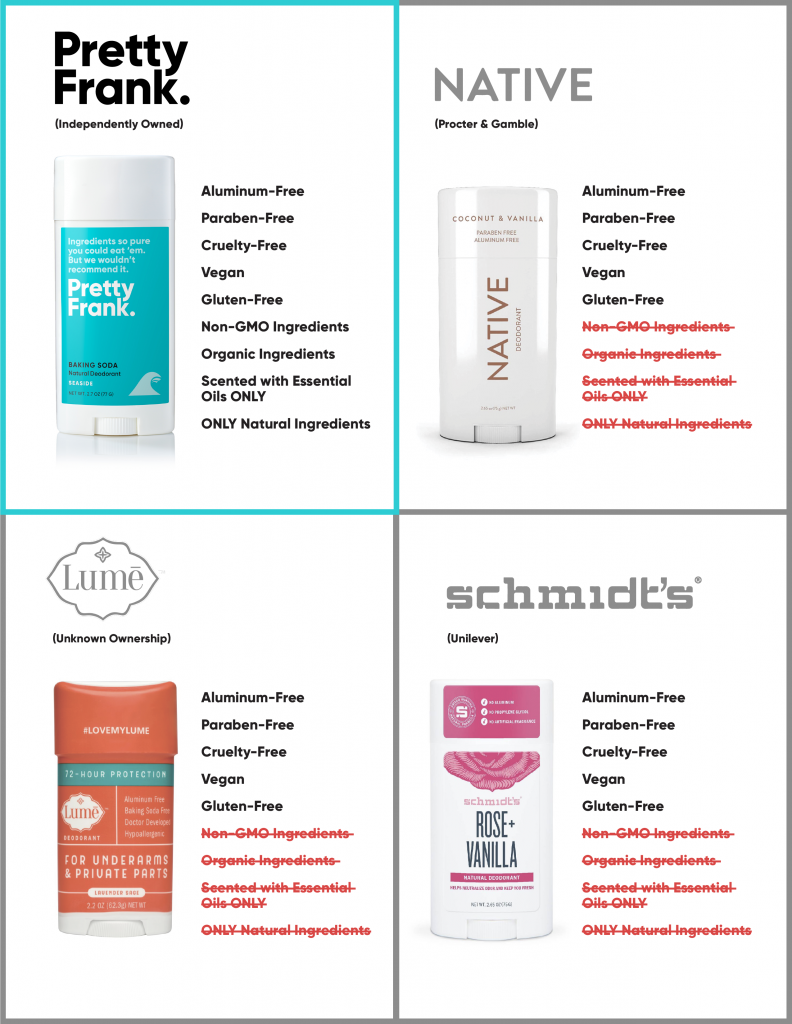February 3, 2020
If you’re here, you probably already know about the risks of using conventional deodorant. In fact, you may have already made the switch to natural deodorant (congrats). But what you may not know is that not all natural deodorants are created equal.
In recent years, more and more people have started demanding better-for-you products, prompting an avalanche of new natural deodorant solutions. This has led to the use of terms like “aluminum-free” and “paraben-free” being plastered on deodorants that actually contain questionable and, frankly, unsafe ingredients. Here’s what you should know if you’re looking for the safest natural deodorant.
Greenwashing & “Natural” Deodorant
The FDA has no legal definition of the term “natural” and no regulations on its use. So it’s not uncommon for companies to leverage the term to sell more products. Known as greenwashing, this practice has become a matter of serious debate in recent years, but it doesn’t seem to be going away anytime soon.
What to Do About It
Read labels.
Simply being aware of the ingredients is the first step to finding the safest natural deodorant. But with little regulation in the industry, there may still be troubling ingredients hiding behind innocuous words like “fragrance.” If you’re not sure what an ingredient is, give it a quick search to find out if you’re comfortable putting it on your body. The Environmental Working Group has an excellent database for this exact purpose.
Seek full transparency.
Certain information, like what exactly is in a fragrance blend, is considered proprietary and therefore companies are not required to disclose the potentially hundreds of chemicals used to create their scents. There’s no telling what goes into making “fragrance” or even “natural fragrance.” Look for brands that are honest and up-front about exactly what they’re putting in their products.
Educate yourself.
Whether you’re strolling the aisles of your supermarket or scrolling through Instagram, you won’t be hard-pressed to find a non-aluminum deodorant. But that’s not the only ingredient to be concerned about. Simply leaving out aluminum and parabens does not a safe natural deodorant make. There’s no telling what could be hiding behind that ‘natural’ label: synthetic fragrance, stearates, propylene glycol, parabens, SLS, talc, and more.
Take, for example, Lume deodorant. While it’s heavily marketed as a “natural” deodorant that’s safe for use “anywhere”, the ingredients tell a completely different story. Check out a few of the scariest ones listed on their website.
Ethylene oxide (found in PEG 100) is highly toxic — even in small doses — and was used in World War I nerve gas. Not natural.
Restricted in cosmetic use in Japan, this chemical has documented links to organ system toxicity. Not natural.
A possible reproductive toxin that could cause tumor formation at high doses. Not natural. And they want you to put this stuff on your privates? No thanks.
The safest natural deodorant.
All ingredient lists for Pretty Frank products are posted directly on each product page, so you know exactly what you’re getting. And you won’t find any ingredients you’d have to Google to find out what they are.
What’s in it?
Fresh, natural ingredients like:
- Organic Beeswax
- Organic Shea Butter
- Organic Coconut Oil
- Organic Arrowroot Powder
- Candelilla Wax
- Steam-Distilled Essential Oils
- Non-GMO Vitamin E derived 100% from Sunflowers
- Active ingredients such as non-nano zinc oxide, magnesium hydroxide, coconut charcoal, and non-aluminum baking soda.
What’s not in it?
- Aluminum Compounds
- Parabens
- Stearates
- Triclosan
- Propylene Glycol
- Triethanolamine and Diethanolamine
- Artificial Colors
- Artificial Fragrance
- Multinational Corporate $$
Check out how The Big Guys stack up against our stuff:

